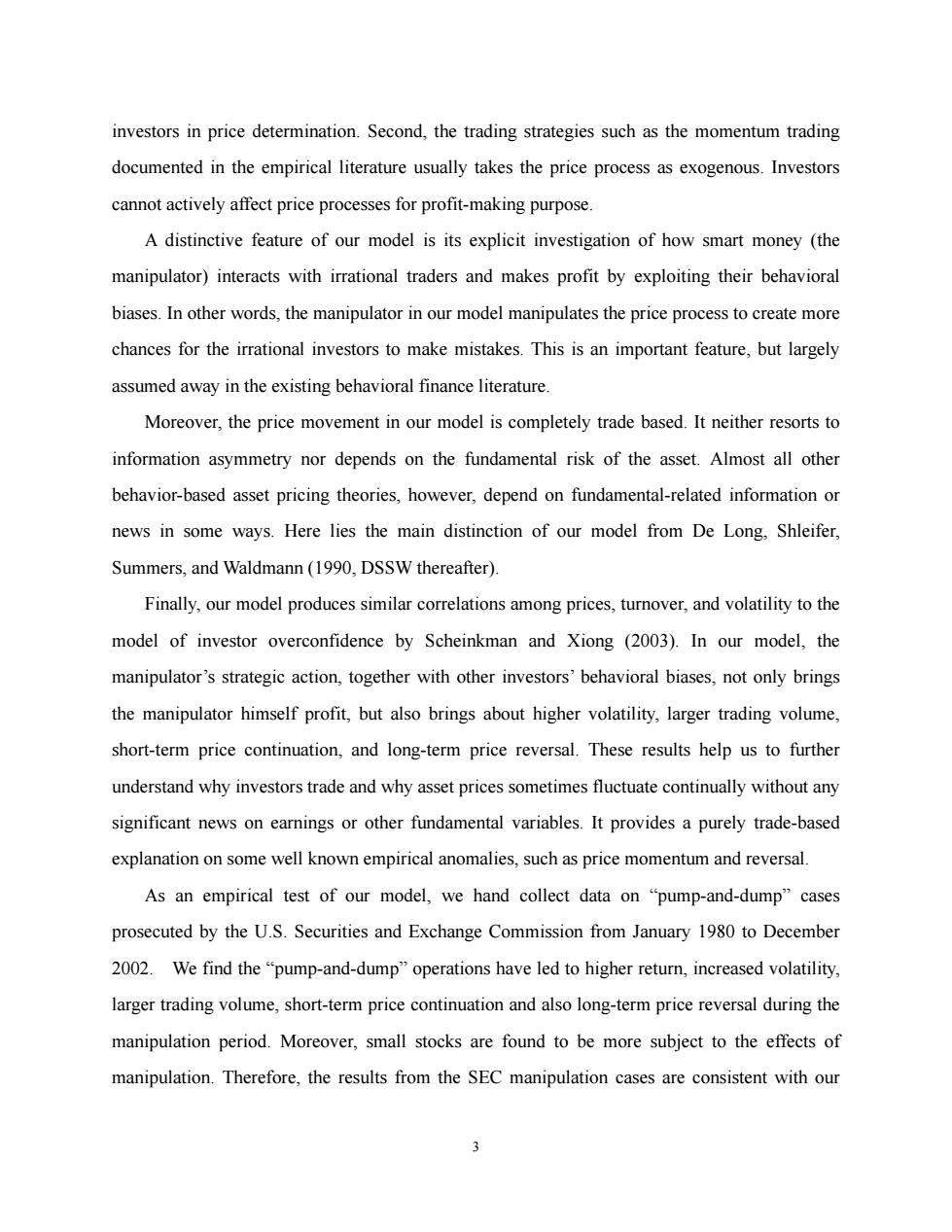正在加载图片...

investors in price determination.Second,the trading strategies such as the momentum trading documented in the empirical literature usually takes the price process as exogenous.Investors cannot actively affect price processes for profit-making purpose. A distinctive feature of our model is its explicit investigation of how smart money (the manipulator)interacts with irrational traders and makes profit by exploiting their behavioral biases.In other words,the manipulator in our model manipulates the price process to create more chances for the irrational investors to make mistakes.This is an important feature,but largely assumed away in the existing behavioral finance literature. Moreover,the price movement in our model is completely trade based.It neither resorts to information asymmetry nor depends on the fundamental risk of the asset.Almost all other behavior-based asset pricing theories,however,depend on fundamental-related information or news in some ways.Here lies the main distinction of our model from De Long,Shleifer, Summers,and Waldmann(1990,DSSW thereafter). Finally,our model produces similar correlations among prices,turnover,and volatility to the model of investor overconfidence by Scheinkman and Xiong (2003).In our model,the manipulator's strategic action,together with other investors'behavioral biases,not only brings the manipulator himself profit,but also brings about higher volatility,larger trading volume, short-term price continuation,and long-term price reversal.These results help us to further understand why investors trade and why asset prices sometimes fluctuate continually without any significant news on earnings or other fundamental variables.It provides a purely trade-based explanation on some well known empirical anomalies,such as price momentum and reversal. As an empirical test of our model,we hand collect data on "pump-and-dump"cases prosecuted by the U.S.Securities and Exchange Commission from January 1980 to December 2002.We find the"pump-and-dump"operations have led to higher return,increased volatility, larger trading volume,short-term price continuation and also long-term price reversal during the manipulation period.Moreover,small stocks are found to be more subject to the effects of manipulation.Therefore,the results from the SEC manipulation cases are consistent with our 33 investors in price determination. Second, the trading strategies such as the momentum trading documented in the empirical literature usually takes the price process as exogenous. Investors cannot actively affect price processes for profit-making purpose. A distinctive feature of our model is its explicit investigation of how smart money (the manipulator) interacts with irrational traders and makes profit by exploiting their behavioral biases. In other words, the manipulator in our model manipulates the price process to create more chances for the irrational investors to make mistakes. This is an important feature, but largely assumed away in the existing behavioral finance literature. Moreover, the price movement in our model is completely trade based. It neither resorts to information asymmetry nor depends on the fundamental risk of the asset. Almost all other behavior-based asset pricing theories, however, depend on fundamental-related information or news in some ways. Here lies the main distinction of our model from De Long, Shleifer, Summers, and Waldmann (1990, DSSW thereafter). Finally, our model produces similar correlations among prices, turnover, and volatility to the model of investor overconfidence by Scheinkman and Xiong (2003). In our model, the manipulator’s strategic action, together with other investors’ behavioral biases, not only brings the manipulator himself profit, but also brings about higher volatility, larger trading volume, short-term price continuation, and long-term price reversal. These results help us to further understand why investors trade and why asset prices sometimes fluctuate continually without any significant news on earnings or other fundamental variables. It provides a purely trade-based explanation on some well known empirical anomalies, such as price momentum and reversal. As an empirical test of our model, we hand collect data on “pump-and-dump” cases prosecuted by the U.S. Securities and Exchange Commission from January 1980 to December 2002. We find the “pump-and-dump” operations have led to higher return, increased volatility, larger trading volume, short-term price continuation and also long-term price reversal during the manipulation period. Moreover, small stocks are found to be more subject to the effects of manipulation. Therefore, the results from the SEC manipulation cases are consistent with our